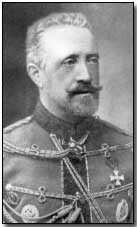Primary Documents - Grand Duke Nikolai on the Battle of the Carpathian Passes, April 1915
 Reproduced below is the
official report written by the Russian Army Commander-in-Chief
Grand Duke
Nikolai - the uncle of
Tsar Nicholas II - with
regard to the Battle of the Carpathian Passes which was conducted in March
and April 1915.
Reproduced below is the
official report written by the Russian Army Commander-in-Chief
Grand Duke
Nikolai - the uncle of
Tsar Nicholas II - with
regard to the Battle of the Carpathian Passes which was conducted in March
and April 1915.
The Grand Duke reported that in spite of heroic Austro-Hungarian resistance the Russian Army enjoyed great success during the period, and that concerted Austrian counterattacks were thrown back.
Click here to read an Austrian officer's memoir of fighting in the campaign.
The Battle of the Carpathian Passes by Russian Army Commander-in-Chief Grand Duke Nikolai, April 1915
At the beginning of March (Old Style), in the principal chain of the Carpathians, we only held the region of the Dukla Pass, where our lines formed an exterior angle. All the other passes-Lupkow and further east-were in the hands of the enemy.
In view of this situation, our armies were assigned the further task of developing, before the season of bad roads due to melting snows began, our positions in the Carpathians which dominated the outlets into the Hungarian plain. About the period indicated great Austrian forces, which had been concentrated for the purpose of relieving Przemysl, were in position between the Lupkow and Uzsok Passes.
It was for this sector that our grand attack was planned. Our troops had to carry out a frontal attack under very difficult conditions of terrain. To facilitate their attack, therefore, an auxiliary attack was decided upon on a front in the direction of Bartfeld as far as the Lupkow. This secondary attack was opened on March 19th and was completely developed.
On the 23rd and 28th of March our troops had already begun their principal attack in the direction of Baligrod, enveloping the enemy positions from the west of the Lupkow Pass and on the east near the source of the San.
The enemy opposed the most desperate resistance to the offensive of our troops. They had brought up every available man on the front from the direction of Bartfeld as far as the Uzsok Pass, including even German troops and numerous cavalrymen fighting on foot.
His effectives on this front exceeded 300 battalions. Moreover, our troops had to overcome great natural difficulties at every step.
Nevertheless, from April 5th - that is, eighteen days after the beginning of our offensive - the valour of our troops enabled us to accomplish the task that had been set, and we captured the principal chain of the Carpathians on the front Reghetoff-Volosate, I10 versts [about 70 miles] long.
The fighting latterly was in the nature of actions in detail with the object of consolidating the successes we had won.
To sum up: On the whole Carpathian front, between March 19th and April 12th, the enemy, having suffered enormous losses, left in our hands, in prisoners only, at least 70,000 men, including about 900 officers. Further, we captured more than thirty guns and 200 machine guns.
On April 16th the actions in the Carpathians were concentrated in the direction of Rostoki. The enemy, notwithstanding the enormous losses he had suffered, delivered, in the course of that day, no fewer than sixteen attacks in great strength. These attacks, all of which were absolutely barren of result, were made against the heights which we had occupied further to the east of Telepovce.
Source: Source Records of the Great War, Vol. V, ed. Charles F. Horne, National Alumni 1923
A bunker comprised a fortification largely built below ground level.
- Did you know?
